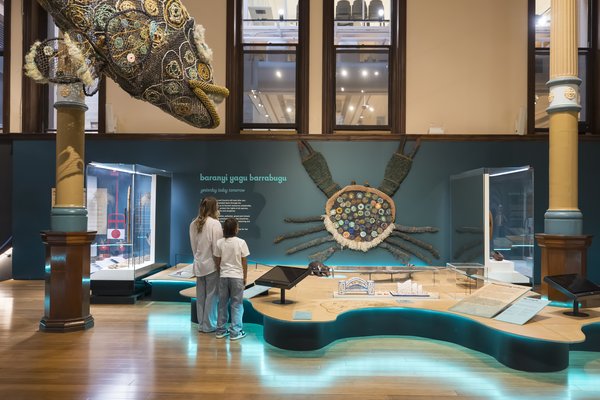Learning language in GADI
Sydney is built upon some of the oldest occupied territory in the world. Before it was named Sydney, it was called Gadi. Our men are Gadigal, men of the grass tree. Our women are Gadigelleon, women of the grass tree. The Australian Museum’s new exhibition GADI, presented as part of Weave, a Festival of Aboriginal and Pacific culture, invites visitors to learn ngara (knowledge) to listen, hear and think about the Country and culture of the place we now know as Sydney.

Jodi leads the Illawarra Flame Trees into ceremony during Ngawiya Maan (we take to give), an audio visual piece by Amanda Jane Reynolds as part of Weave, the Festival of Aboriginal and Pacific Cultures. Photo by Eliyah Cohen © Stella Stories 2018, courtesy Australian Museum.
Image: Eliyah Cohen© Stella Stories
There were approximately 250 Aboriginal languages and around 600 dialects spoken in Australia before colonisation. Many Aboriginal languages have been lost due to government and social policies that banned and discouraged Aboriginal people from speaking their languages.
Around 145 Aboriginal languages are spoken today (110 of these are critically endangered) and only 60 languages are spoken fluently as a first language. Less than 20 Aboriginal languages are spoken in New South Wales. The loss of Aboriginal languages is far greater in Australia than other native-speaking countries.
The Australian Museum’s Indigenous staff has used the GADI exhibition as a way to teach both non-Indigenous and Aboriginal and Torres Strait Islander Peoples the Sydney language.
Here are a few examples to get you started:
budga mugarai – G’day mate!
gadi – Grass tree. The word Gadigal is derived from gadi. The gadi are unique to this continent and not too long ago, Sydney’s landscape was defined by their presence.
bugi and bagi – bugi means bark and bagi means skin. The linguistic relationship between these words reflects the deep connection our culture draws between the biology of plants and humans. Our land and language go hand in hand.
nawi – Canoe. We had a nawi culture, as salt water – as much as land – was our Country. The nawi allowed us to travel around the Harbour and rivers quickly and easily. These were our natural highways.
narawang – Paddle. These instruments would help us to steer and propel our nawi. If they started to leak we could seal them with gurrundurrang (paperbark) and gadi resin.
mahn – Sydney’s fisherwomen. Even before we could walk we would sit in nawis, clasped between our mothers’ knees and ankles, as they fished.
Discover more about Gadigal people and Country in GADI, presented as part of Weave, a Festival of Aboriginal and Pacific Culture.













